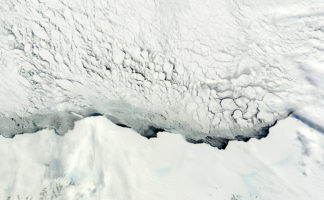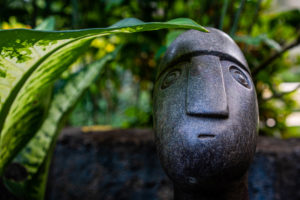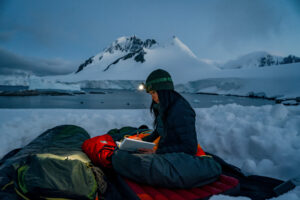Support Hidden Compass
Our articles are crafted by humans (not generative AI). Support Team Human with a contribution!
Banks of fog crept in as we hiked down over the barrens. We were on the edge of the island, seemingly at the edge of the known world, and about to enter a mystery. Twelve of us accordioned out on the trail, an easy two miles to the bottom of the Avalon Peninsula. Once assembled at Mistaken Point, we would step foot on a surface of 565-million-year-old rocks. Here were the Ediacaran fauna, fossils of the oldest complex life forms on Earth.
For more than a decade I had wanted to see these fernlike creatures embedded on the edge of Newfoundland, after an article in a scientific journal put them on my radar. Called rangeomorphs, they bore no resemblance either to the trilobites who came after them or the so-called “small shelly fossils” that predate them. Unanchored, they confound biology.
What were these strange relics of deep time?
~~
When the path dipped, we passed into a tuckamore — a dense thicket of spruce trees stunted by the elements. Our guide, a middle-aged woman with wavy blond hair and a confident voice, said the trees, despite being only 6 to 8 feet tall, were easily 100 years old. We stopped here and there to pick blueberries, red partridgeberries, and tart yellow cloudberries.
As we skirted the shore, the perpetual roar of wave on rock became louder. Gannets appeared in the crags. In a cove, a seal poked its head out of the water. Finally, I glimpsed the layered slabs of coastal rocks, piled up millions of years ago.
Charles Darwin wrote, “A man must for years examine for himself great piles of superimposed strata … before he can hope to comprehend anything of the lapse of time.”
In foggy conditions like today, sailors who mistook Mistaken Point for Cape Race would turn north, expecting to reach a calm harbor and instead wreck upon the rocks. Now it is one of Earth’s exposed memories, emphatic and concrete.
As we neared the coast, I imagined a young Shiva Misra camping out here on the windswept tip of the peninsula. As a grad student in the 1960s, he immersed himself in this hostile terrain when his fellow geology classmates wouldn’t. With only caribou and ptarmigan for companions, Misra hiked up and down the rock ledges of the headlands, carefully watching every step amid the fog and crashing waves.
Locals must have told him about the “flowers” in the rocks, which he identified for the first time as ancient animal forms in 1967. In his research paper about his discovery, he described these rangeomorphs as “impressions of leaves on mud” and alluded to their mysterious origins: “This obviously once flourishing fauna appears to be unlike any known fauna.”
Here I was about to explore the same site, a distant clearing in the wilderness of time.
~~
On my desk sits a small trilobite — no bigger than my thumb. Its head, ribbed thorax, and tail bulge darkly out of its gray rock bed. It is both stone and not stone, an accident of preservation as well as a captive of its era. I discovered it many years ago in a Manhattan shop; I thought such things could only be found in museums. It turned out to be a specimen of Elrathia kingii, the most common trilobite in the world. I saw this creature, ubiquitous in oceans some 515 million years ago, as an exclamation point: I existed! The salesperson wrapped it in tissue, like a rare gem, and placed it in a small box. When I left the shop, I felt I had my own talisman of time and for a while it was my most prized possession.
~~
On my way to Mistaken Point, I stopped at Manuels River, along the top of the island. Here, on “a very wet and cold afternoon in the summer of 1974,” physicist-turned-trilobite expert Riccardo Levi-Setti found one of his most incredible trilobite fossils. As a physicist compelled by science and beauty alike, he developed and refined imaging techniques that revealed unprecedented detail in everything from the tracks of elementary particles to the surfaces of materials. As a paleontologist, he had an eye for collecting trilobites, a passion that he described as both time travel and treasure hunt. His curiosity led him to become a world authority.
On that rainy afternoon, Levi-Setti was digging in the shale beds exposed in the gorge at Manuels River when he discovered a giant specimen of Paradoxides — a Middle Cambrian species previously found in Bohemia, Sweden, and Wales. The paleontological lore of the previous centuries flashed in his mind. He wrote, “It was uncanny to me that all of a sudden I could hold in my hand such a treasure,” something he only knew from old photographs. “Now I was holding this fantastic trilobite, bright yellow and red, even more so under the rain, that was once buried in a very distant and very old Europe,” he continued. “I could touch the amazing reality of continental drift.”
If I could have touched it, I would have. But the specimen now resides under glass at the interpretation center. I leaned up close to better examine its exquisite detail. As long as my arm, it was by far the largest trilobite I had ever seen. Long fringes hung down from the ends of its ribs as if midswim.
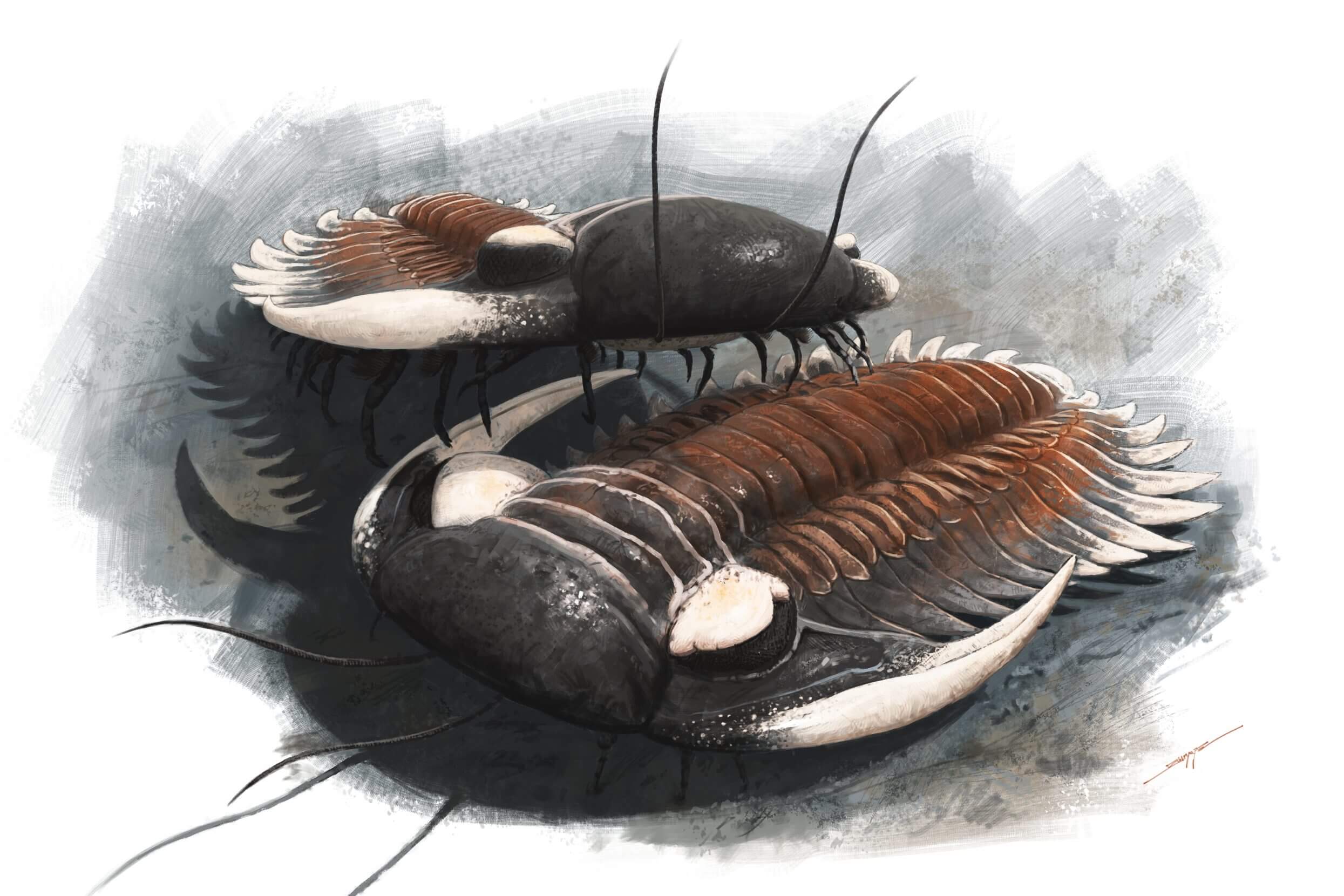
Paradoxides are believed to have been predatory trilobites from the Middle Cambrian era. Painting by Henry Sharpe.
Its hard shell marked a new innovation that Ediacaran fauna, like those at Mistaken Point, lacked — a good reason trilobites became some of Earth’s most successful animals, diversifying into 20,000 species over almost 300 million years before dwindling and fading away once and for all in a mass extinction 250 million years ago. I envied Levi-Setti’s good fortune for striking his knife into the rock and pulling out such an impressive slab of history.
I took a short walk along Manuels River and soon saw a cliff of dark shales that looked like a place where Levi-Setti could have hunted for trilobites, its layers stacked 20 feet high over the shallow river. Darwin encouraged traipsing among the strata like this. He wrote, “A man must for years examine for himself great piles of superimposed strata, and watch the sea at work, grinding down old rocks and making fresh sediment, before he can hope to comprehend anything of the lapse of time, the monuments of which we see around us.”
My mind couldn’t fathom which was slower: erosion and sedimentation, or continental drift. Once, this was all ocean and the strata were assembled one grain at a time. Once, you could walk from Manuels River to Wales or Morocco.
Such processes are easier to imagine than the numbers. There were not 500 or 5,000 trips of Earth around the sun between me and the trilobites here, but 500,000,000. What’s more, the Ediacaran fossils I came to see at Mistaken Point predate the trilobites at Manuels River by 65 million years — the same span that separates us from the extinction of the dinosaurs. We live in a lightning bolt in the great storm of being.
~~
Just as I reached the end of the trail at Mistaken Point, the sun broke through the fog and cast a dazzling light on the crag. I climbed down the rocky outcropping, exchanged my boots for cotton slippers that the guide called “booties,” and eagerly ascended to the broad, flat fossil beds.
Suddenly I felt the need to walk even more softly. My prize spread out before me on two ledges sloped into the cliff, one six feet above the other, as big as a tennis court. Dozens of strange shapes burst from the surface — proto-ferns and primal leaves, but neither fern nor leaf. Preserved by volcanic ash that has mostly eroded away, they appeared to sway in an unseen current. The bed itself was rippled, as if long ago a series of waves was caught here and frozen.
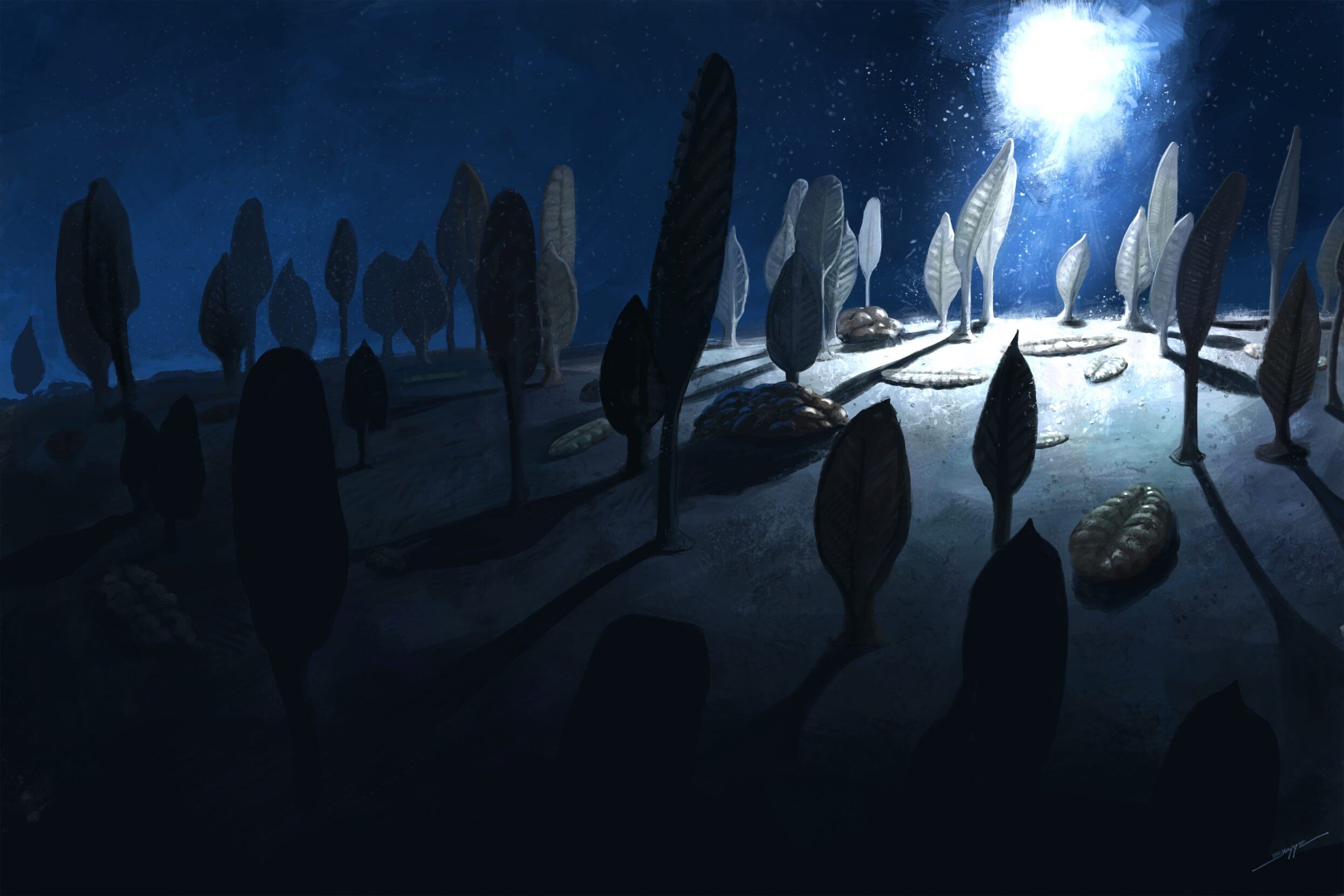
An imagined diver’s light illuminates a sea of rangeomorphs on the floor of the primordial ocean. Painting by Henry Sharpe.
Because the lower bed had restricted access, after viewing from the periphery, I climbed to the upper bed where we were allowed to wander freely. The guide warned us not to stray too close to the edge. Everywhere I looked, fabulous cones and fans and spindles bulged out of the stone, like a Miró mural.
What were they? Did they really not move? How were they connected to the animals that came after, including us? Were they even animals?
In each rangeomorph, fractal branches radiate from a central stem. The ultimate in simple design, the same modular form repeats on smaller and smaller scales, like a koan whose mystery grows level by level. Thought to have lived on the ocean floor, too deep for photosynthesis, these enigmas likely absorbed nutrients through their bodies. They could grow to be 6 feet high, but most were only a few inches in length.
The guide handed me a laminated index sheet and I tried to identify some rangeomorphs by name. One of the most common spindle-shaped fossils was Fractofusus misrai, named after Shiva Misra. Around me, I found several with 20 pairs of ribs of interwoven fronds, tapered at each end. The guide pointed out Charniodiscus procerus, which looked like a skeleton key with a hole at one end and a frond attached to the other. Another was known as the “feather duster.” Flopped this way and that, the preservation was astonishing. I felt as if I was snorkeling over an ancient sea floor.
Again and again, I tried to get my bearings. Mistaken Point wasn’t underwater here — it was underwater 40 degrees south of the equator, half a billion years ago. Before everything we know: mammals, dinosaurs, amphibians, and fish. Even before trilobites. As the geological periods drifted past, ancient Newfoundland formed as a result of multiple continental collisions and the opening and closing of the Iapetus Ocean. Somewhere along the way, a nearby volcano covered this seascape with ash. Now with all the pieces in place, waves lapped at the base of the ledge, sometimes, we were told, with enough force to splash over.
With so many fossils strewn about underfoot, I found it hard to focus on any of them, like a hummingbird flitting from one bloom to the next.
Though there are some 30 Ediacaran fossil sites around the world, the rangeomorphs’ connection to the animals of the Cambrian era — the fast swimmers, with exoskeletons and mouths, the weird wonders of the Burgess Shale — remains a mystery. The leading idea is that maybe they are part of their own “Avalon” explosion that ultimately whimpered out. As if a garden of marvelous life-forms flourished for 30 million years and then vanished. Glaciers, wind, and waves slowly revealed their echoes.
We live in a lightning bolt in the great storm of being.
I could have wandered for hours over the fossil bed, letting my untethered mind roam over vast sweeps of time and space. With the moody sunlight and the fog, I was caught between now and a prehistoric dawn, imagining these early strivings as the continents roamed. Wondering. Reveling in the unknown.
I wanted to linger, to see how they stood out or hid as the sun rolled over the sky, to see the moon and Milky Way rise over the fossils, to mentally breathe life into them again on the ocean floor. But we had to make way for the next group, so reluctantly I changed out of my booties and back into my hiking boots.
On the hike back, our group once more accordioned out and I drifted over the barrens, as if in my own ocean current. I picked some blueberries, one by one letting them burst in my mouth, feeling that Nature herself had whispered a wonderful, cryptic secret to me.
Whatever they were and however they were connected to us — if they were connected at all — rangeomorphs pushed the origin of complex life 30 million years earlier, before the start of the Cambrian era. They existed. The past is deeper and richer than we know.
Now exposed to the elements, even these impressions will one day fade away, a reminder that — if we are lucky — we, too, will one day become another of Earth’s memories.
# # #
Henry Sharpe is a Canadian natural sciences illustrator who specializes in prehistoric life. He is a paleontology student at the University of Alberta with a penchant for hiking in Crocs.
Daniel Hudon
Daniel Hudon is a writer and educator based in Boston who likes to get lost in nature, particularly among old trees.

